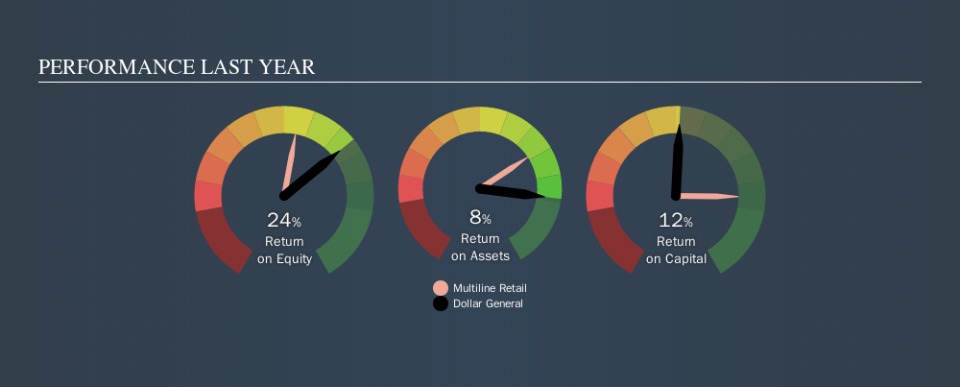Is Dollar General Corporation (NYSE:DG) Investing Effectively In Its Business?

Today we'll look at Dollar General Corporation (NYSE:DG) and reflect on its potential as an investment. In particular, we'll consider its Return On Capital Employed (ROCE), as that can give us insight into how profitably the company is able to employ capital in its business.
Firstly, we'll go over how we calculate ROCE. Next, we'll compare it to others in its industry. Finally, we'll look at how its current liabilities affect its ROCE.
Return On Capital Employed (ROCE): What is it?
ROCE is a metric for evaluating how much pre-tax income (in percentage terms) a company earns on the capital invested in its business. Generally speaking a higher ROCE is better. Ultimately, it is a useful but imperfect metric. Renowned investment researcher Michael Mauboussin has suggested that a high ROCE can indicate that 'one dollar invested in the company generates value of more than one dollar'.
How Do You Calculate Return On Capital Employed?
Analysts use this formula to calculate return on capital employed:
Return on Capital Employed = Earnings Before Interest and Tax (EBIT) ÷ (Total Assets - Current Liabilities)
Or for Dollar General:
0.12 = US$2.2b ÷ (US$22b - US$4.3b) (Based on the trailing twelve months to August 2019.)
Therefore, Dollar General has an ROCE of 12%.
View our latest analysis for Dollar General
Does Dollar General Have A Good ROCE?
ROCE is commonly used for comparing the performance of similar businesses. Using our data, Dollar General's ROCE appears to be around the 12% average of the Multiline Retail industry. Separate from Dollar General's performance relative to its industry, its ROCE in absolute terms looks satisfactory, and it may be worth researching in more depth.
Dollar General's current ROCE of 12% is lower than 3 years ago, when the company reported a 23% ROCE. So investors might consider if it has had issues recently. You can click on the image below to see (in greater detail) how Dollar General's past growth compares to other companies.
When considering this metric, keep in mind that it is backwards looking, and not necessarily predictive. ROCE can be deceptive for cyclical businesses, as returns can look incredible in boom times, and terribly low in downturns. ROCE is only a point-in-time measure. What happens in the future is pretty important for investors, so we have prepared a free report on analyst forecasts for Dollar General.
Dollar General's Current Liabilities And Their Impact On Its ROCE
Current liabilities are short term bills and invoices that need to be paid in 12 months or less. Due to the way the ROCE equation works, having large bills due in the near term can make it look as though a company has less capital employed, and thus a higher ROCE than usual. To counter this, investors can check if a company has high current liabilities relative to total assets.
Dollar General has total assets of US$22b and current liabilities of US$4.3b. As a result, its current liabilities are equal to approximately 20% of its total assets. Low current liabilities are not boosting the ROCE too much.
Our Take On Dollar General's ROCE
Overall, Dollar General has a decent ROCE and could be worthy of further research. There might be better investments than Dollar General out there, but you will have to work hard to find them . These promising businesses with rapidly growing earnings might be right up your alley.
If you like to buy stocks alongside management, then you might just love this free list of companies. (Hint: insiders have been buying them).
We aim to bring you long-term focused research analysis driven by fundamental data. Note that our analysis may not factor in the latest price-sensitive company announcements or qualitative material.
If you spot an error that warrants correction, please contact the editor at editorial-team@simplywallst.com. This article by Simply Wall St is general in nature. It does not constitute a recommendation to buy or sell any stock, and does not take account of your objectives, or your financial situation. Simply Wall St has no position in the stocks mentioned. Thank you for reading.



